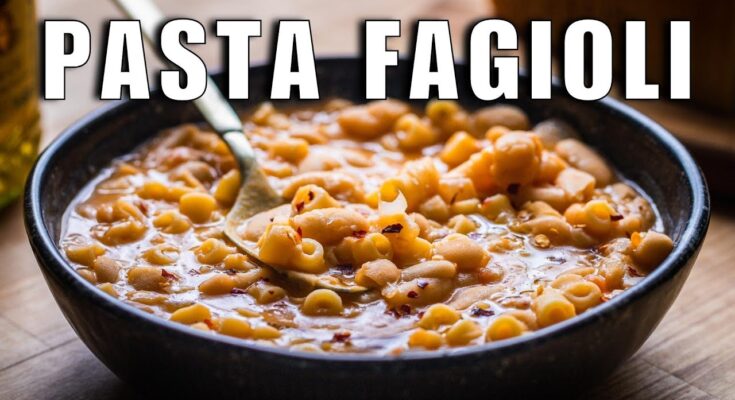Pasta e Fagioli Recipe: Pasta e Fagioli, which translates to “pasta and beans,” is a classic Italian comfort food that’s been warming hearts and bellies for generations. This hearty soup blends two humble staples—pasta and beans—into a rich, flavorful dish that’s greater than the sum of its parts. It’s one of those meals that proves you don’t need expensive ingredients or fancy techniques to create something delicious. Typically made with simple pantry items, this dish is affordable, filling, and incredibly satisfying.
Unlike some Italian dishes that lean on heavy sauces or complex meats, Pasta e Fagioli celebrates rustic simplicity. With a base of sautéed aromatics like garlic, onions, and celery (known as a “sofrito”), the soup is built up with tomatoes, broth, and beans—usually cannellini or borlotti. Short pasta varieties like ditalini or elbow macaroni are added, making each spoonful a delightful mix of textures and tastes.
Whether you’re cooking for a cozy family dinner or meal prepping for the week, Pasta e Fagioli is a go-to option that never disappoints.
The History Behind This Hearty Dish
This dish has roots that stretch deep into Italian peasant cuisine. Originally, Pasta e Fagioli was a meal of necessity—born from the rural kitchens of central and southern Italy where beans and pasta were often all that was available. It was a symbol of making the most with what little you had. No extravagant ingredients, just pantry basics that when combined thoughtfully, created magic in a bowl.
As Italian immigrants brought their culinary traditions to America, Pasta e Fagioli gained popularity, especially in Italian-American households. Over time, countless variations evolved—some with meat, others with greens, and some with a spicy kick. What remains constant, however, is its soul: a dish that nourishes, comforts, and satisfies on every level.
Ingredients Needed
Main Ingredients
To create the classic version of Pasta e Fagioli, you’ll need the following key ingredients. Each one plays a crucial role in flavor and texture:
- Olive Oil: A good-quality extra virgin olive oil starts things off right, adding richness and depth.
- Onion, Carrot, and Celery: These three form the aromatic base of the dish and are essential for that classic Italian flavor.
- Garlic: Adds a fragrant, slightly spicy punch.
- Tomatoes: Either crushed canned tomatoes or fresh diced tomatoes give the soup a lightly acidic, savory body.
- Beans: Cannellini or borlotti beans are traditional. You can use canned for convenience or dried if you have more time.
- Pasta: Ditalini is the most common, but elbow macaroni or small shells work well too.
- Vegetable or Chicken Broth: Broth enhances the flavor and creates a rich, hearty soup.
- Bay Leaf and Fresh Herbs: Bay leaves, thyme, or rosemary can elevate the taste, while fresh parsley adds brightness at the end.
- Salt and Pepper: Don’t forget to season each layer to bring out all the flavors.
Optional Add-ins and Variations
While the basic recipe is perfect on its own, feel free to customize it to your taste:
- Parmesan Rind: Tossing one into the pot as it simmers adds incredible umami depth.
- Pancetta or Bacon: If you’re not going vegetarian, sautéing a bit of pancetta at the beginning adds smoky richness.
- Spinach or Kale: Adding greens towards the end can boost nutrition and color.
- Red Pepper Flakes: A dash brings a welcome bit of heat.
- White Wine: Deglazing the pan with wine after the sofrito step adds a layer of complexity.
Kitchen Tools You’ll Need
You won’t need any fancy gadgets to whip up Pasta e Fagioli, just some good kitchen basics:
- Large Soup Pot or Dutch Oven: A heavy-bottomed pot distributes heat evenly and holds all your ingredients comfortably.
- Sharp Knife: For chopping all those veggies.
- Wooden Spoon or Spatula: Perfect for stirring the sofrito and soup.
- Measuring Cups and Spoons: To keep your ingredient ratios on point.
- Colander or Strainer: To rinse beans or drain pasta if needed.
- Ladle: Essential for serving up hearty bowls of this delicious soup.
Step-by-Step Instructions
Step 1: Prepping the Ingredients
Before you start cooking, take the time to prep everything. This step is often overlooked but is crucial for smooth execution.
- Chop your aromatics: Dice one medium onion, two medium carrots, and two celery stalks. Aim for small, even pieces so they cook evenly.
- Mince the garlic: About 3-4 cloves should do, depending on your garlic preference.
- Open and rinse beans: If using canned beans, rinse them well under cold water to remove excess sodium and preserve the flavor.
- Measure your pasta: Around 1 cup of ditalini or small pasta.
- Chop herbs: Finely chop fresh parsley or thyme if using.
Having everything ready means you won’t be scrambling mid-cook—and trust me, future you will be grateful for the prep work.
Step 2: Cooking the Base (Sofrito)
This is where the flavor journey begins.
- Heat about 2–3 tablespoons of olive oil in a large soup pot over medium heat.
- Add chopped onions, carrots, and celery. Sauté for 8–10 minutes until softened and golden.
- Stir in the garlic and cook for another minute until fragrant.
- (Optional) Add pancetta at this point if you’re using it, and cook until crispy.
- Season lightly with salt and pepper to build flavor from the start.
The smell of the sofrito is reason enough to make this dish—it’s like a warm hug in your kitchen.
Step 3: Adding Beans and Broth
Now that your sofrito is beautifully fragrant and golden, it’s time to build the soul of the soup—adding the beans and broth.
- Add your tomatoes: Pour in a can of crushed tomatoes (around 14-15 oz) or the same amount of fresh, chopped tomatoes. Stir well to combine with the sautéed vegetables.
- Simmer the mixture: Let the tomato base simmer for 5–10 minutes so it thickens slightly and the flavors begin to meld.
- Add beans: Stir in two cans of drained and rinsed cannellini or borlotti beans. If you’re using dried beans that you cooked earlier, add about 2 cups.
- Pour in broth: Add about 4–5 cups of vegetable or chicken broth. Stir everything together and bring the soup to a gentle boil.
At this stage, you can toss in a bay leaf, a parmesan rind, and a few sprigs of thyme or rosemary. These aromatics infuse your soup with deep, complex flavors that’ll make each spoonful taste like it simmered all day.
Reduce the heat and let everything simmer for 15–20 minutes. This gives the beans time to soak up all that delicious flavor.
Step 4: Cooking the Pasta
This step is more delicate than it seems. Pasta in soup can be tricky because it tends to keep cooking even after the heat’s off. Here’s how to do it right:
- Add pasta directly to the soup: Once your broth and beans are bubbling gently, stir in the pasta. Let it cook uncovered, stirring occasionally, until just al dente (usually 7–9 minutes, depending on the shape).
- Watch the texture: Be careful not to overcook it—the pasta will continue to soften in the hot broth even after you remove it from the stove.
- Alternative method: If you’re planning to store leftovers, consider cooking the pasta separately and adding it to individual bowls when serving. This prevents mushy pasta and gives you better control over consistency.
Once the pasta is ready, taste your soup and adjust the seasoning. You’ll likely need more salt and pepper, and maybe a splash of water or broth if it’s gotten too thick.
Step 5: Finishing Touches
This is where you turn your humble soup into a masterpiece.
- Add chopped parsley: A generous handful of fresh parsley adds a pop of color and brightness.
- Drizzle with olive oil: A swirl of high-quality extra virgin olive oil just before serving enhances the flavor.
- Serve with grated cheese: Freshly grated Parmesan or Pecorino Romano takes it over the top. Let each person sprinkle their own for that extra cheesy magic.
- Add a splash of balsamic vinegar (optional): This might sound unconventional, but a tiny splash can balance the richness and add depth.
Let the soup rest for 5 minutes before serving—it gives everything time to settle and become more flavorful. Spoon it into bowls, top with cheese, and grab a slice of crusty bread. Heaven.
Tips for the Best Pasta e Fagioli
Want to make your Pasta e Fagioli taste like grandma made it? Here are some pro tips that’ll take your soup from good to “can I have seconds?”
- Use quality ingredients: This dish is all about simple flavors. That means good olive oil, fresh herbs, and flavorful broth can make all the difference.
- Don’t rush the sofrito: Let those veggies caramelize slowly. They’re the flavor backbone of your soup.
- Let it rest: Like many soups, Pasta e Fagioli tastes even better after sitting for a while. The flavors meld together and deepen.
- Go easy on the pasta: It can soak up a ton of liquid. Stick to about 1 cup unless you’re cooking for a crowd.
- Use a parmesan rind: It’s a game-changer. Toss it in while the soup simmers and let it melt into a savory flavor bomb.
- Add greens: Kale, spinach, or Swiss chard make the soup heartier and more nutritious without overpowering the flavor.
- Make it your own: Try different beans, spices, or even a squeeze of lemon for a twist.
With just a few tweaks and a little love, your Pasta e Fagioli will become a regular in your kitchen rotation.
How to Store and Reheat
This dish is fantastic for meal prep, and honestly, it might taste even better the next day.
Storing Leftovers:
- Refrigerator: Let the soup cool completely before transferring it to an airtight container. It will keep in the fridge for up to 4–5 days.
- Freezer: Pasta e Fagioli freezes well, but we recommend freezing the soup without the pasta. Pasta tends to turn mushy when thawed. Store the soup base in freezer-safe containers for up to 3 months.
Reheating Tips:
- On the stove: Pour the soup into a pot and reheat over medium heat, stirring occasionally. Add a splash of water or broth if it’s too thick.
- In the microwave: Heat in 60-second intervals, stirring in between. Again, add a bit of liquid to loosen it up if needed.
- Add fresh pasta if frozen: If you froze the soup without pasta, cook some separately and add it in when you reheat for the best texture.
Proper storage and gentle reheating mean you can enjoy this comforting dish multiple times with just as much flavor as day one.
Serving Suggestions
Pasta e Fagioli is one of those versatile dishes that works as a full meal, a starter, or even a hearty side depending on how you serve it. Here are a few ideas to elevate your experience:
As a Main Course:
- Crusty Bread or Garlic Bread: Nothing soaks up that rich, brothy goodness quite like a slice of warm, crusty bread. Toasted garlic bread with butter is another great option.
- Side Salad: A crisp arugula or Caesar salad brings a refreshing crunch that contrasts beautifully with the warm, creamy soup.
- Grated Cheese on the Table: Let everyone add their own Parmesan or Pecorino—just like in a cozy Italian trattoria.
As a Starter:
If you’re serving a multi-course Italian meal, Pasta e Fagioli makes an excellent primo (first course) before a meat or fish-based secondi.
For Meal Prep or Leftovers:
Divide the soup into meal-sized containers, and you’ve got a wholesome, filling lunch for the next few days. Pair it with a quick salad or some roasted vegetables for a balanced plate.
Nutritional Information
One of the reasons Pasta e Fagioli is such a beloved dish is its nutritional balance. It’s packed with protein, fiber, and complex carbohydrates—thanks to the beans and pasta—while also being low in fat and full of essential vitamins from the vegetables.
Typical Nutrition Per Serving (about 1.5 cups):
- Calories: 300–400 kcal
- Protein: 12–16g
- Fat: 6–10g (mostly from olive oil and optional cheese)
- Carbohydrates: 45–55g
- Fiber: 8–10g
- Sugar: 5–8g (from tomatoes and carrots)
- Sodium: 600–800mg (can vary depending on broth and canned goods used)
This makes it an excellent option for vegetarians, budget-conscious eaters, and anyone looking for a satisfying but nutritious meal.
Common Mistakes to Avoid
Even a simple recipe like Pasta e Fagioli can go sideways if you’re not careful. Here’s what to avoid:
1. Overcooking the Pasta:
It continues to cook in the hot soup, so always aim for slightly undercooked (al dente) when adding it to the pot.
2. Skipping the Sofrito:
Don’t just dump everything into a pot and hope for the best. Taking the time to properly sauté your onions, carrots, and celery makes a world of difference in flavor.
3. Using Unseasoned Broth:
Low-sodium broth is a great choice for control, but it can be bland if not seasoned. Taste and adjust accordingly!
4. Not Resting the Soup:
Let it sit for at least 5 minutes after cooking to allow the flavors to meld. Better yet, make it a day in advance!
5. Using Too Much Pasta:
Resist the urge to dump in the whole box. Pasta expands and will soak up your broth, turning your soup into more of a stew (which isn’t bad, just different).
Avoid these pitfalls, and your Pasta e Fagioli will be just as comforting and delicious as it’s meant to be.
Variations Across Italy
Like many Italian dishes, Pasta e Fagioli has regional identities that bring a delightful twist depending on where it’s made:
Northern Italy:
- Creamier versions are common, often blended slightly for a smoother texture.
- More likely to include pancetta or prosciutto.
- Sometimes served with a side of polenta.
Central Italy (Tuscany, Lazio):
- Focuses on fresh herbs like rosemary and sage.
- Often cooked with hearty greens like cavolo nero (Tuscan kale).
Southern Italy (Naples, Calabria):
- Tends to be spicier—think red pepper flakes and a more tomato-heavy broth.
- More rustic and often meatless.
Every version shares the same heart and soul but brings a unique touch, reflecting the ingredients and traditions of each region. You can easily take inspiration from these variations and tweak your recipe to match your favorite flavors.
Make It Vegetarian or Vegan
The traditional version of Pasta e Fagioli is often vegetarian, and with just a few tweaks, it can be made fully vegan without sacrificing flavor.
To Make It Vegetarian:
- Use vegetable broth instead of chicken.
- Skip pancetta or any meat-based additions.
- Stick to cheese for richness.
To Make It Vegan:
- Use vegetable broth.
- Omit cheese or use a plant-based alternative.
- Add more umami with ingredients like a splash of soy sauce, nutritional yeast, or a bit of miso paste.
The beans, tomatoes, herbs, and veggies do so much heavy lifting in this dish that you won’t miss the animal products at all.
FAQs about Pasta e Fagioli Recipe
What is Pasta e Fagioli?
Pasta e Fagioli, which translates to “pasta and beans,” is a traditional Italian soup known for its hearty blend of pasta, beans, and aromatic vegetables in a savory broth. It’s a staple comfort food across Italy, each region adding its own twist to this classic dish.
What type of pasta works best in Pasta e Fagioli?
Small pasta shapes like ditalini, elbow macaroni, or mini farfalle are perfect for Pasta e Fagioli as they complement the size of the beans and ensure every spoonful is packed with flavor. These shapes also hold up well in the hearty broth without becoming too soft.
Can Pasta e Fagioli be made vegetarian?
Absolutely! To make a vegetarian version of Pasta e Fagioli, simply omit any meat components and use vegetable broth instead of chicken or beef broth. Enhance the flavor with more herbs and spices like basil, thyme, and a bay leaf.
How long does Pasta e Fagioli last in the refrigerator?
Properly stored in an airtight container, Pasta e Fagioli can last in the refrigerator for up to 4-5 days. The flavors often deepen over time, making the leftovers even more delicious.
Is Pasta e Fagioli freezable?
Yes, Pasta e Fagioli freezes quite well. Cool the soup completely before transferring it to freezer-safe containers. Leave a little headspace as the soup will expand when frozen. Thaw in the refrigerator overnight and reheat gently, adding a splash of water if the soup seems too thick.
What are the best beans to use in Pasta e Fagioli?
Traditionally, cannellini beans or borlotti (cranberry) beans are used in Pasta e Fagioli. These beans are great at absorbing flavors and add a creamy texture to the soup. However, feel free to use any hearty beans you prefer or have on hand.
Conclusion
Pasta e Fagioli is more than just a soup—it’s a warm embrace in a bowl. With its humble ingredients and rich, comforting flavor, this traditional Italian dish brings both heart and heritage to your table. Whether you follow the classic version or put your own spin on it, one thing’s for sure: it’s a meal that feeds the soul.
Take your time with each step, don’t skimp on the aromatics, and be generous with your love. That’s the real secret to great Pasta e Fagioli.



